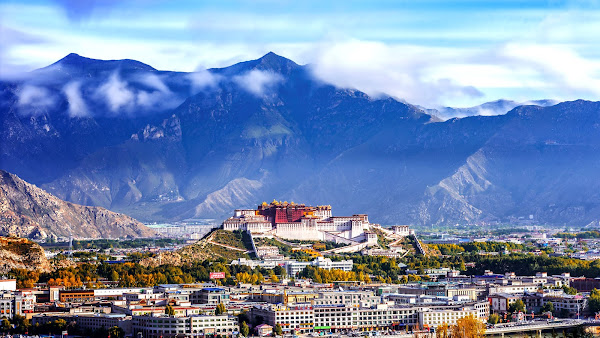Religions have had a close relationship not only with violence but with economic exploitation. Indeed, it is often the economic exploitation that necessitates the violence. Such was the case with the Tibetan theocracy. Until 1959, when the Dalai Lama last presided over Tibet, most of the arable land was still organized into manorial estates worked by serfs. These estates were owned by two social groups: the rich secular landlords and the rich theocratic lamas. Even a writer sympathetic to the old order allows that
a great deal of real estate belonged to the monasteries, and most of them amassed great riches. Much of the wealth was accumulatedthrough active participation in trade, commerce, and money lending.Drepung monastery was one of the biggest landowners in the world, with its 185 manors, 25,000 serfs, 300 great pastures, and 16,000 herdsmen. The wealth of the monasteries rested in the hands of small numbers of high-ranking lamas. Most ordinary monks lived modestly and had no direct access to great wealth. The Dalai Lama himself
lived richly in the 1000-room, 14-story Potala Palace.
The theocracy’s religious teachings buttressed its class order. The poor and afflicted were taught that they had brought their troubles upon themselves because of their wicked ways in previous lives. Hence they had to accept the misery of their present existence as a karmic atonement and in anticipation that their lot would improve in their next lifetime. The rich and powerful treated their good fortune as a reward for, and tangible evidence of, virtue in past and present lives.
Michael Parenti
I stumbled upon this article during the scandal involving the Dalai Lama a couple of months ago. My – cynical – immediate reaction was to observe that we rarely hear anything about China’s persecution of Tibetans in the news these days, as the narrative refocused on Hong Kong’s forced integration, the repression of the Uyghurs, and now the increasingly tense atmosphere around Taiwan. Americans sure love to point out other countries’ human rights abuses, while doing little to combat them and forgetting about the issue as soon as another ‘crisis’ pops up – almost as if the concern is merely performative, designed not to help the abused, but to reinforce the American public’s self-perception as ‘the good guys’ versus the ostensive enemy-of-the-day, and to subtly undermine the sovereignty of the state in question.

I’m sure the article above has its share of bias: published on a website run by self-proclaimed comrades, it’s bound to portray Communist China in a favorable light. The living conditions and society it describes resemble the European Middle Ages, where the Christian Churches also had considerable wealth and political power, so this history seems entirely plausible.
Over the centuries the Tibetan lords and lamas had seen Chinese come and go, and had enjoyed good relations with Generalissimo Chiang Kaishek and his reactionary Kuomintang rule in China. The approval of the Kuomintang government was needed to validate the choice of the Dalai Lama and Panchen Lama. When the current 14th Dalai Lama was first installed in Lhasa, it was with an armed escort of Chinese troops and an attending Chinese minister, in accordance with centuries-old tradition. What upset the Tibetan lords and lamas in the early 1950s was that these latest Chinese were Communists. It would be only a matter of time, they feared, before the Communists started imposing their collectivist egalitarian schemes upon Tibet.
The issue was joined in 1956-57, when armed Tibetan bands ambushed convoys of the Chinese Peoples Liberation Army. The uprising received extensive assistance from the U.S. Central Intelligence Agency (CIA), including military training, support camps in Nepal, and numerous airlifts. Meanwhile in the United States, the American Society for a Free Asia, a CIA-financed front, energetically publicized the cause of Tibetan resistance, with the Dalai Lama’s eldest brother, Thubtan Norbu, playing an active role in that organization. The Dalai Lama’s second-eldest brother, Gyalo Thondup, established an intelligence operation with the CIA as early as 1951. He later upgraded it into a CIA-trained guerrilla unit whose recruits parachuted back into Tibet.
It would have been fascinating to see how Tibetan society would have evolved had it remained relatively independent of the central Chinese government – my guess is that this theocratic feudal hierarchy would have collapsed sooner rather than later. Tibet’s status between 1912 and 1951 as a de facto independent state bears remarkable similarity to current-day Taiwan: a self-governed province that the rest of the world officially regards as part of China, while the central government in Beijing lacks the power to assert its authority. One has to wonder whether – or rather when – a similar resolution will unfold with Taiwan…
I never quite understood the public infatuation with the Dalai Lama. There’s clearly a tendency to romanticize the Orient as a place of mysticism and exotic traditions, but in this case the fame felt exaggerated. To recount another lesson from Dune, the more you idealize a leader, either political or spiritual (or both!), the harder it becomes for them to live up to this larger-than-life persona – and the harsher the disillusionment and backlash when they inevitably fail, being merely human like the rest of us.
Post a Comment